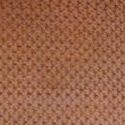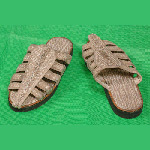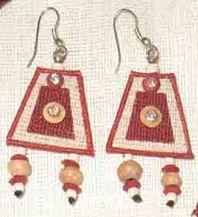Jute Craft of Uttarakhand,
Jute is a vegetable fibre derived from the bark of a reed-like plant grown mainly in the subtropical areas of Asia, especially India, Bangladesh, and China. It is the second largest plant fibre after cotton and is available in large quantities. India also happens to be the largest producer of jute and jute products as the crop is grown in 83 districts of the eastern region of the country primarily West Bengal, Assam, Odisha, Bihar, Uttar Pradesh, Tripura and Meghalaya. The crop required abundant rainfall, grows best in warm, humid areas and takes between four and six months to mature, growing to a height of 3-4 metres. The planting season for jute is between March and May and the harvesting is done between June and September. The mature plant is cut close to ground level and laid on the field for a day or two to allow the leaves to fall off. The most useful part of the plant is the bast fibre. This is separated easily from the plant by a process known as retting, in which the embedded fibre is separated from the stem by immersing the jute plants in water. Tan to brown are natural shades of jute however, the absorbent fiber can be bleached and dyed. It is environment friendly, biodegradable and thus, considered to be an appropriate choice for use.
Jute is a vegetable fibre derived from the bark of a reed-like plant grown mainly in the subtropical areas of Asia, especially India, Bangladesh, and China. It is the second largest plant fibre after cotton and is available in large quantities. India also happens to be the largest producer of jute and jute products as the crop is grown in 83 districts of the eastern region of the country primarily West Bengal, Assam, Odisha, Bihar, Uttar Pradesh, Tripura and Meghalaya. The crop required abundant rainfall, grows best in warm, humid areas and takes between four and six months to mature, growing to a height of 3-4 metres. The planting season for jute is between March and May and the harvesting is done between June and September. The mature plant is cut close to ground level and laid on the field for a day or two to allow the leaves to fall off. The most useful part of the plant is the bast fibre. This is separated easily from the plant by a process known as retting, in which the embedded fibre is separated from the stem by immersing the jute plants in water. Tan to brown are natural shades of jute however, the absorbent fiber can be bleached and dyed. It is environment friendly, biodegradable and thus, considered to be an appropriate choice for use.
Jute Craft of West Bengal,
Jute, also known as the golden fibre, is the cheapest natural fibre. Jute is a vegetable fibre, derived from the bark of a reed like plant grown mainly in the subtropical areas of Asia, especially India, Bangladesh and China. It is the second largest plant fibre after cotton and is available in large quantities. Although some decorative items are produced of it, largely jute is employed in producing utilitarian items. Jute items are gaining popularity because it's the cheapest known natural fibre and are a 100% eco-friendly. Since the early 1800's, Bengal has been known to produce maximum quantity of Jute all over the world. As a result Bengal boasts of a repertoire of jute crafts. Craftsperson's here create a wide variety of utilitarian items from jute. An elegant range of home décor, furnishings, and garments, hanging lamps, baskets, flower vases, purses, table mats and footwear made out of woven jute fibre are gaining popularity. Jute is also used for making baskets, mats and beautiful toys. Fabrics made of jute may be decorated with tie and dye, embroidery and block printing. The jute planters faced a huge loss due to the discovery of polythene and nylon in 1970's. However, since the trend of eco-friendliness became famous, jute was once again in high demand and it has been profitable for the jute farmers too. An important function jute serves is for packaging purpose. Cereals, vegetables, cement and numerous other things are packaged in the sacks made by jute.
Jute, also known as the golden fibre, is the cheapest natural fibre. Jute is a vegetable fibre, derived from the bark of a reed like plant grown mainly in the subtropical areas of Asia, especially India, Bangladesh and China. It is the second largest plant fibre after cotton and is available in large quantities. Although some decorative items are produced of it, largely jute is employed in producing utilitarian items. Jute items are gaining popularity because it's the cheapest known natural fibre and are a 100% eco-friendly. Since the early 1800's, Bengal has been known to produce maximum quantity of Jute all over the world. As a result Bengal boasts of a repertoire of jute crafts. Craftsperson's here create a wide variety of utilitarian items from jute. An elegant range of home décor, furnishings, and garments, hanging lamps, baskets, flower vases, purses, table mats and footwear made out of woven jute fibre are gaining popularity. Jute is also used for making baskets, mats and beautiful toys. Fabrics made of jute may be decorated with tie and dye, embroidery and block printing. The jute planters faced a huge loss due to the discovery of polythene and nylon in 1970's. However, since the trend of eco-friendliness became famous, jute was once again in high demand and it has been profitable for the jute farmers too. An important function jute serves is for packaging purpose. Cereals, vegetables, cement and numerous other things are packaged in the sacks made by jute.
Jute Jewellery of West Bengal,
Jute is a natural fiber. Today it finds many uses in contemporary products like bags, shoes and even jewelry. Jute is called as golden fiber. Jute is cultivated all over India and a source of livelihood for many. Women are major contributors in the value chain of jute products from farmers to product makers. Jute jewelry included necklace and earring sets. Jute is dyed in different colours to get vibrant jewelry. Value addition of different colored beads is also done on the jewelry.
Jute is a natural fiber. Today it finds many uses in contemporary products like bags, shoes and even jewelry. Jute is called as golden fiber. Jute is cultivated all over India and a source of livelihood for many. Women are major contributors in the value chain of jute products from farmers to product makers. Jute jewelry included necklace and earring sets. Jute is dyed in different colours to get vibrant jewelry. Value addition of different colored beads is also done on the jewelry.
Jute Ropes and Weaving of Anand, Gujarat,
Jute fiber, extracted from the thin bark and the woody core of the reed, is spun by hand into ropes and woven into cloth. With new innovations, the fiber has extended its use to a range of products. [gallery ids="176385,176386,176384"]
Jute fiber, extracted from the thin bark and the woody core of the reed, is spun by hand into ropes and woven into cloth. With new innovations, the fiber has extended its use to a range of products. [gallery ids="176385,176386,176384"]
Jute Weaving of Almora, Uttrakhand,
Jute is a vegetable fibre derived from the bark of a reed-like plant grown mainly in the subtropical areas of Asia, especially India, Bangladesh, and China. It is the second largest plant fibre after cotton and is available in large quantities. India also happens to be the largest producer of jute and jute products as the crop is grown in 83 districts of the eastern region of the country primarily West Bengal, Assam, Odisha, Bihar, Uttar Pradesh, Tripura, and Meghalaya. The crop required abundant rainfall grows best in warm, humid areas and takes between four and six months to mature, growing to a height of 3-4 meters. The planting season for jute is between March and May and the harvesting is done between June and September. The mature plant is cut close to ground level and laid on the field for a day or two to allow the leaves to fall off. The most useful part of the plant is the bast fibre. This is separated easily from the plant by a process known as retting, in which the embedded fiber is separated from the stem by immersing the jute plants in water. Tan to brown are natural shades of jute however, the absorbent fiber can be bleached and dyed. It is environment-friendly, biodegradable and thus, considered to be an appropriate choice for use.


Jute is a vegetable fibre derived from the bark of a reed-like plant grown mainly in the subtropical areas of Asia, especially India, Bangladesh, and China. It is the second largest plant fibre after cotton and is available in large quantities. India also happens to be the largest producer of jute and jute products as the crop is grown in 83 districts of the eastern region of the country primarily West Bengal, Assam, Odisha, Bihar, Uttar Pradesh, Tripura, and Meghalaya. The crop required abundant rainfall grows best in warm, humid areas and takes between four and six months to mature, growing to a height of 3-4 meters. The planting season for jute is between March and May and the harvesting is done between June and September. The mature plant is cut close to ground level and laid on the field for a day or two to allow the leaves to fall off. The most useful part of the plant is the bast fibre. This is separated easily from the plant by a process known as retting, in which the embedded fiber is separated from the stem by immersing the jute plants in water. Tan to brown are natural shades of jute however, the absorbent fiber can be bleached and dyed. It is environment-friendly, biodegradable and thus, considered to be an appropriate choice for use.






